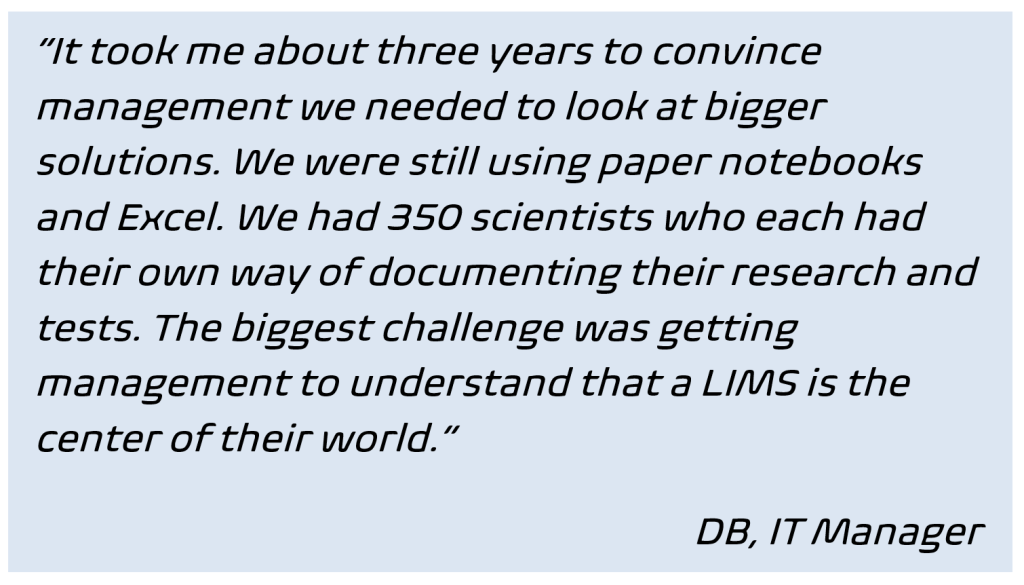
Investing in a new Laboratory Information Management System (LIMS) — or even your lab’s first LIMS — is a big step. The team who runs the day-to-day business of the lab may know just how beneficial such a change can be, especially if they’ve worked in another laboratory that uses a modern informatics system. It can, however, be difficult to convince your decision-makers and other stakeholders of the need – and the value.
Management doesn’t always recognize how a laboratory information management system can (and should) be the center of a lab. They also may not be aware of the many advantages of such an investment.
You may not be the one who holds your lab’s purse strings. But that doesn’t mean you can’t be a catalyst for positive change. If you’re ready to add or upgrade a LIMS in your organization, here are five steps to help you develop an appropriate change management process.
1. Build the case for change
People are often resistant to change because they worry it will create more work, stress, or complicate their jobs. One of the best ways to turn the conversation around is to focus on how a LIMS will make their lives easier. What problems could a modern LIMS solve for them?
Just like every other task in a laboratory, effective change begins with data gathering. Ask yourself and your team:
- What are the inefficiencies or gaps in your lab workflows?
- Do you have dozens of technicians who are each tracking their work in Excel spreadsheets — or worse — paper notebooks that are not easily accessible?
- Is your team struggling with data or workstream silos or the need to duplicate data entry into antiquated or incompatible systems?
- Are you missing decision making opportunities hidden in plain sight in your data?
Don’t just look for logical reasons. Many of us who work in science-driven professions are prone to this common mistake. Remember, emotions play a significant role in the decision-making process even in major enterprises. If lab managers hate filling out reports or routine compliance paperwork, for example, the idea that a LIMS could automate those tasks might be just as compelling as the ways it will save your lab time or money.
2. Know your options
Having a clear idea of the pros and cons of your available alternatives will be critical to building your case.
- Would your lab be better served by a standard LIMS, or one built for a specific industry, such as pharmaceuticals, oil and gas, or forensic crime labs?
- Would a secure web portal reduce bottlenecks with your clients or team members working remotely?
- Just as important: What happens if nothing changes?
 One change manager we recently worked with created a master spreadsheet that detailed every requirement the lab needed to satisfy. She used it to evaluate every LIMS system her organization was considering. For each possible system she ranked every requirement on a point scale: zero points if it didn’t offer any functionality, one point if it required some effort to realize the vision, and two if it did exactly what they wanted out of the box.
One change manager we recently worked with created a master spreadsheet that detailed every requirement the lab needed to satisfy. She used it to evaluate every LIMS system her organization was considering. For each possible system she ranked every requirement on a point scale: zero points if it didn’t offer any functionality, one point if it required some effort to realize the vision, and two if it did exactly what they wanted out of the box.
3. Map out the full impact
Any change that involves a LIMS could potentially cause major reverberations throughout your organization. If everyone is still working with paper or spreadsheets, you may need to harmonize multiple workflows, data streams, or even technologies. In fact, every person on your team might currently be handling their work in their own unique way, which can be a source of potential friction and change resistance.
If you already have a LIMS in place, you will also have to account for changes to hardware, software, maintenance plans and more. Data may need to be migrated and the LIMS itself may need to be revalidated.
Evaluating all the consequences up front may seem like a daunting task, but it’s essential to your preparation. Having a complete picture will enable you to play the “devils’ advocate” and prepare well-crafted responses to objections.
4. Get buy-in from your team
Before you approach the executive team, start building support from the rest of your team – and from others in the organization who will be impacted (most often in positive ways). This is a great time to showcase the work you’ve done in the first three steps. Transparent communication will be critical at this stage. If you’ve done your prep work well, you’ll be able to acknowledge what might change, address any apparent pitfalls, and make a convincing case for how lab operations will improve.
 Think about getting your colleagues on board as a kind of “dress rehearsal” before you go to your leadership team. Take advantage of this step to uncover potential objections you may not have considered and refine your final proposal.
Think about getting your colleagues on board as a kind of “dress rehearsal” before you go to your leadership team. Take advantage of this step to uncover potential objections you may not have considered and refine your final proposal.
5. Make the pitch
Once you’ve built a strong case, compared alternatives, built a realistic picture of what needs to be done, and secured support from some of your colleagues, it’s time to make the case to your key decision-makers. This can be stressful, especially if you’re putting yourself forward as a potential change manager.
One of the best ways to minimize your concerns is to learn as much as you can about your stakeholders and how they might benefit — individually and collectively — from your proposed LIMS purchase and implementation. Keep the focus positive and highlight the benefits rather than the features.
To learn more about how a LabVantage LIMS can power — and empower — your lab, visit the Lab Informatics Solution page.

